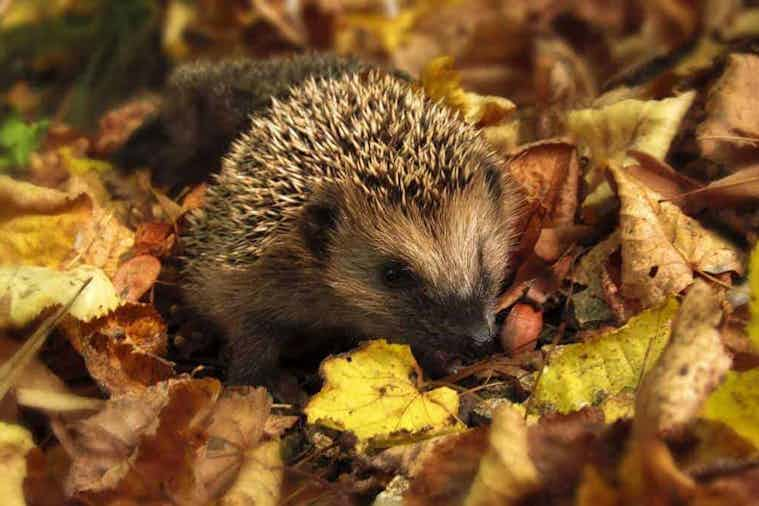Autumn is here bringing with it cold and crisp mornings, falling leaves and the darker nights. It might seem like it's time to hang up your gardening shears and hibernate indoors for the winter. Don’t worry; there are still plenty of opportunities to have a glorious garden throughout the autumn months.
Autumn is the perfect time to have a good tidy up and prepare your garden and plants for winter and for the spring too! So don’t put your gardening tools away just yet, let's take a look at what you can be doing in your garden through autumn.
It’s time for a good tidy
Colder weather brings new problems to your garden. It’s best to deal with some of the potential problems before they even occur.
Tidy away garden furniture
Garden furniture and decor is especially vulnerable to changing temperatures. Frost, rain and damp air will cause damage to all these items. So, as soon as the autumn weather arrives, it’s time to put furniture and decorations away.
Make sure you give your furniture a good clean and apply any preserving treatments necessary. Then, either cover or put all these neatly in a shed or indoor space. If you still want to use your garden for a while longer, then you can pop a chair or two within easy access. Then on those sunny autumn days, you can still grab your chair and enjoy the garden. But don’t forget to put the furniture away again at the end of the day.
Tidy your beds, borders and hedges
Your flower beds are susceptible to damage during autumn. You can avoid this by keeping them tidy. Remove any annual plants by digging them up at the root and then give your beds a good weed. Make sure they are clear of any debris, including fallen leaves. Finally, look at your perennials. Remove any dead leaves and then prune any plants that need it at this time of year. This will encourage them to come back strong in spring.
Once you have taken care of the weeding and pruning, cut back any hedges. Use a hedge trimmer to cut away any dead foliage or branches.
Tidy up your lawn
If you have trees nearby, falling leaves will be a problem. Make sure you rake these up regularly and add them to your compost bin. Raking with a wire rake will also help to weed out any moss any unwanted growths in your lawn.
Autumn is also the perfect time for some lawn care. Early autumn is the best time to reseed any bare patches of grass that need a helping hand. Scatter your lawn seeds and then sprinkle a little soil over the top. Don’t cover up the grass completely; this can cause further damage to your lawn.
Autumn is also a great time to top up your lawn with some extra nutrients. Buy yourself an autumn specific lawn feed and follow the instructions. Feeding your lawn will help it survive the winter.
Finally, give your lawn the last cut of the year with a good lawnmower; this will stop most of its growth over the colder months. Giving it a good cut now will help to keep your garden looking neat and tidy until spring. This also makes your first cut of next year much easier to handle.
Have some autumn plants in your garden
Autumn is a beautiful time of year with stunning bronze and gold colours to enjoy. Most plants will start to die off when summer ends. This can leave your garden feeling a little bare. You can avoid this by ensuring you have some autumn flowering plants to add interest and colour. Pick flowers such as anemone’s, astor, cyclamen and hesperantha. Buy these already established from the garden centre. Or, you can plan ahead and grow them from seed throughout the growing season.
Plant your bulbs
You can ensure you have a fantastic show of spring flowers by putting in the effort now. Grab yourself a selection of spring bulbs such as tulips, snowdrops and daffodils and start planting. You need to plant these bulbs in autumn. They will lay dormant beneath the soil until it’s time for the weather to change and they can grow.
Protect your plants
Once you have completed your bulb planting, you need to protect your borders and your plants.
Protecting pots
Once your pot plants have died out then make sure you remove them and any soil from the pot. Give the pot a good clean and then store them away in a shed until spring. Move any pots that contain perennials to a sheltered area or cover them.
Protect your border plants
You can protect the roots of hardy perennial plants by adding some mulch to your beds. Add a ring of mulch around the roots of shrubs and trees. You need to add about a 2-inch layer over weeded soil; this works to trap in moisture and adds an extra layer of protection from frost.
Move fragile plants indoors
Take note of the plants you have in your flower beds. Some perennials will do better kept away from the cold and frosty mornings. There is no definitive list of these plants. It will depend on what is in your garden and how important each plant is to you. An excellent tip to follow is to move your favourite plants indoors. For example, do you have a selection of herbs, a beautiful bay tree, or a stunning fuchsia that you have spent all year cultivating? Bring them indoors and don't let your hard work go to waste! Move the plants indoors and keep on tending it throughout autumn and winter. If you do plan to move any of your plants indoors or into a greenhouse, make sure you only pick healthy plants. These are the plants that are free from pests and disease. Bringing one plant with pests into an environment with lots of plants can cause the issue to spread through to all your plants.
Take care of local wildlife
Autumn is the time of year that your local wildlife might need a helping hand. Many species are harvesting and hoarding nuts and seeds to keep themselves fed throughout the winter. Some are preparing to hibernate. Other species are preparing themselves for a long, cold autumn and winter.
When gardening, take care not to disturb any hibernating hedgehogs. You can encourage them to hibernate in a safe area by providing a 'wild area' of your garden, which remains untouched. If you have cats and dogs, make sure you fence off the area, so they leave the hedgehogs alone. You can also put out appropriate food and water. The best type of food recommended by the British Hedgehog Preservation Society is plain meaty cat foods.
Birds can also start to struggle during the autumn months. So, top up your birdbaths and bird feeders with nuts, seeds and some fat balls.
Taking care of your garden in autumn
As you can see, there is plenty to be getting on with during autumn. You can plant your bulbs outdoors and start planning your seeds and garden for the next season. This is the time to protect your plants and get ready for frosty mornings and winter weather. Autumn is also a great time to give your garden a good tidy up. So, grab your trimmers, shears and trowel and get your garden prepared.








